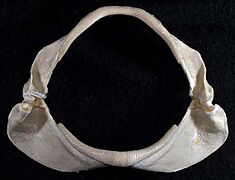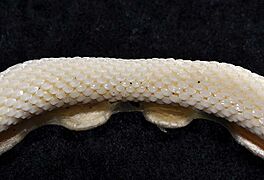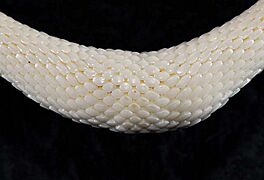Speckled smooth-hound facts for kids
Quick facts for kids Speckled smooth-hound |
|
|---|---|
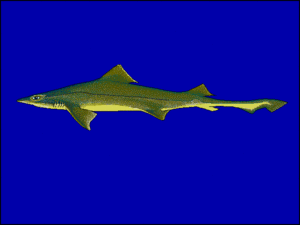 |
|
| Conservation status | |
| Scientific classification | |
| Genus: |
Mustelus
|
| Species: |
mento
|
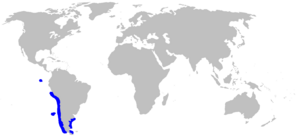 |
|
The speckled smooth-hound (Mustelus mento) is a type of houndshark. It belongs to the family called Triakidae. This shark lives in the eastern Pacific Ocean, along the underwater edge of the land called the continental shelf. You can find it in waters between the equator and about 54 degrees south, usually at depths from 16 and 50 m (52 and 164 ft). These sharks can grow up to 130 cm (51 in) long. In some areas, this shark and a few others are known as "tollo."
Contents
About the Speckled Smooth-hound
The speckled smooth-hound is a strong shark with a snout that is a bit rounded. It has small eyes and a short mouth. Its teeth are flat, like molars, and don't have sharp points. The back edges of its top fins have small, pointy parts. Its front fins are large, and its belly fins are a good size too. The part of its body before the tail is short, and the bottom part of its tail fin is narrow and slightly curved.
How Big Do They Get?
The biggest speckled smooth-hound found was about 130 cm (51 in) long. Male sharks are ready to have babies when they are about 70 cm (28 in) long. Females are ready when they reach about 88 cm (35 in). Adult sharks are grey or brownish-grey on top and lighter underneath. They have many small white spots, which is how they get their name! Younger sharks have dark stripes or bars on their bodies.
Where They Live
The speckled smooth-hound lives off the Pacific coast of South America. This includes places like the Galapagos Islands and the Juan Fernández Islands. Their home range stretches from Isla Lobos de Tierra in Peru all the way down to the southern tip of Chile.
Their Ocean Home
This shark is a demersal fish, which means it swims close to the ocean floor. It prefers the continental shelf, in waters that are usually between 16 and 50 m (52 and 164 ft) deep. Sometimes, people mistakenly report seeing this shark in the Atlantic Ocean near Argentina. However, those sightings are likely of a different shark called the narrownose smooth-hound (Mustelus schmitti), which also has white spots.
Life Cycle and Reproduction
The speckled smooth-hound has a special way of having babies. It is ovoviviparous. This means the eggs develop and hatch inside the mother's body. The baby sharks then grow inside her until they are ready to be born. When they are born, the young sharks are about 30 cm (12 in) long. Usually, a mother shark will have about seven babies at a time.
Conservation Status
The speckled smooth-hound is often caught by local fishermen. They call it "tollo," along with other sharks like the humpback smooth-hound (Mustelus whitneyi) and the spotted houndshark (Triakis maculata). Fishermen often use gill nets to catch them.
Protecting the Sharks
In Chile, the number of these sharks caught was highest in 1989, around 1300 tons. But since then, the numbers have dropped a lot, to less than 200 tons per year. This shows that there are fewer sharks in the ocean. Because of this, fishermen have started to catch more rays instead. In 2001, Peru made a rule that "tollo" sharks must be at least 60 cm (24 in) long before they can be caught. The IUCN (International Union for Conservation of Nature) has listed the speckled smooth-hound as "critically endangered." This means it is at a very high risk of disappearing forever.



